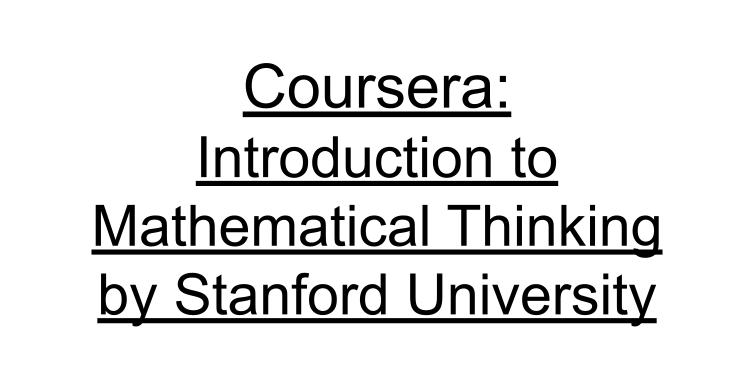引き続き Coursera で面白そうなコースがあったので、受講していきます。
スタンフォード大学の提供する、「数学的思考の導入」ってコースです。ここはもう趣味みたいなもんなんで、のんびりやっていきます。
主に、数学的なものの考え方のおさらいと、ついでに面白い英語表現があれば拾っていきます。
まずはこのコースの目的から、”Learn how to think the way mathematicians do – a powerful cognitive process developed over thousands of years.” 意訳すると、「どのようにして数学的に思考するのかを学ぶ – 数千年かけて発達してきた強力な知覚プロセスについて」みたいな感じです。
講義自体は、YouTube で公開されてます。リンクがこちらにあるので、興味がある人はぜひ。
https://www.youtube.com/watch?v=LN7cCW1rSsI
※ あくまで素人が趣味で防備のノートとしてまとめているだけなので、解釈違い、数学的な厳密さの欠如についてはご容赦ください。
Lecture 1 – Introductory Material
In the 1980s, I was one of a number of mathematicians who advocated a new meme to capture what mathematics is today. The Science of Patterns, according to that description, the mathematician identifies and analyzes abstract patterns.
とありますが、ここで “meme” が使われています。一般的に使われている意味合いで言うと、”an idea, image, video, etc. that is spread very quickly on the internet:” なのですが、この文脈だとどちらかというと、「提言」とも解釈できます。
数学を、「科学のパターン」と呼ぶのは面白いです。
数学において、重要なのは、より緻密に言語を取り扱うこと。 次の二つの文章には大きな違いがある
- One American dies of melanoma almost every hour.
- Almost every hour, an American dies of melanoma.
“One” を使うことによって、「特定の1人」のようなニュアンスが出てくるため、とある人が、1時間に1回死亡する、というよくわかんない文章になってしまう。(ただし、多くの場合、これは文脈によって正しく解釈される)
日常会話では、上のような文脈が「共通の知識」として理解されるが、特に数学においては、そのような「共通の知識」などはないことが普通。よって、”Moreover, in mathematics the need for precision is paramount.” となる。
いわゆる「低文脈(ローコンテクスト)」ってやつです。日本語自体が高文脈な言語と呼ばれるので、日本人は割と苦手な分野かもしれないです。
crash course
Cambridge Dictionary – crash course
a series of lessons that teach you a lot of basic facts or skills in a very short time:
Almost every key statements of mathematics, the axioms, conjectures, hypothesis and theorems is a positive or negative version of one of four linguistic forms.
- axiom:公理
- conjectures:予想
- hypothesis:仮説
- theorem:定理
When that study is carried out in a mathematically formal way, it’s known as formal logic or mathematical logic. The study of mathematical logic is a well-established branch of mathematics studied, and used to this day in University Departments of Mathematics, Computer Science, Philosophy, and Linguistics. It gets a lot more complicated than the original work carried out in ancient Greece by Aristotle and his followers, and by the stoic logicians.
アリストテレスって、Aristotle ってスペリングだし、発音も日本語のそれとだいぶ違う。
an ancient Greek philosopher (= a person who studies the meaning of life) and scientist:
Cambridge Dictionary – Aristotle
「論理学」には2種類、formal logic vs. informal logic がある。
Formal logic is the study of deductively valid inferences or logical truths. It examines how conclusions follow from premises due to the structure of arguments alone, independent of their topic and content.
Wikipedia – Formal logic
Lecture 2 – Logical Combinators
Relative to the conjunction, the two constituents, phi(Φ) and psi(Ψ) are called the conjuncts of Φ∧Ψ. What are the circumstances under which your conjunction phi and psi is true?
“conjuncts” は、普通の英英辞書には載ってなかったです。数学の専門用語ですね。”conjunction” は、コンピュータの演算でいうところの binary operation のうちの論理積のことですね。 A ∧ B です。
そして、同様に
And relative to the disjunction, the constituents phi(Φ) and psi(Ψ) are called the disjuncts.
論理和 A ∨ B では、同様にそれぞれ、A, B のような構成要素が、”disjuncts” と、論理和が “disjnction” となります。
Here is a quick quiz, let A be the sentence, “it will rain tomorrow” and let B be the sentence, “it will be dry tomorrow.” Here’s the question. Does the disjunction A v B accurately reflect the meaning of the sentence, “tomorrow it will rain or it will be dry all day”. Well, what do you think?
これは当然に、数学的な A v B の意味を表すものではないですね。いわゆる、文法的な “or” の意味を成しているだけです。
The standard abbreviation mathematicians use today is this symbol, which is like a negation symbol with a little vertical hook.
これは、否定、”¬” 記号のことです。 ¬A のように示し “The negation of psi.” と読まれます。
また、
Older textbooks you’ll find will use a tilde.
とあるように、古いテキストなどでは、~A のように表記されます。
We should always go for clarity in the case of mathematics. Remember, the whole point of this precision that we try to introduce is to avoid ambiguities to avoid confusions. Because in more advanced situations, all we’re going to have to rely upon is the language. And then, we need to make sure that we’re using language in a non ambiguous and reliable way.
数学では、言語をより厳密かつ明瞭に使いこなすことが大事ってことですね。特に発展的で抽象的な議論をする際に、拠り所となるのは、言語の緻密さだけとなります。
“All foreign cars are badly made.” という文の否定はどのようになる?
- All foreign cars are well made.
- All foreign cars are not badly made.
- At least one foreign car is well made.
- At least one foreign car is not badly made.
そもそも、”All foreign cars are badly made.” 自体が偽である。(現実的に、全ての外国車は作りが悪い、とは言えない)
同様の理由から、選択肢1と2は偽である。よって問題の文の否定にはなり得ない。
つまり、選択肢3または4が、この文の否定になりうる。
では、”All domestic cars are well made.” というような文章は? これは以下の理由から問題の文の否定とはならない。
This one, isn’t even in the ballpark for being a negation, because it’s not talking about foreign cars, it’s talking about domestic cars. Negating a word in a sentence, is not at all the same as negating the sentence. So this one, is a really bad choice.
なお、”ballpark” は、もともと「野球場」のような意味だが、以下のような意味もあり
an acceptable range in the amount or number of something when you do not know or cannot agree on an exact amount or number:
Cambridge Dictionary – ballpark
ballpark
Problem Set 1
到達度テストがあります。Graded test と呼ばれるものです。
内容自体は難しくないのですが、結構パズルを解いている感じがあります。
「アリスのことを全く知らないと仮定して、次の選択肢の中でもっともらしいものはどれ?」 のような問題がありますが、これは、例えば選択肢が “and” キーワードを使っていると条件を狭めることにつながるため、選択肢からは除外される。といった感じの理屈で解いていきます。
反対に、”or” キーワードのある選択肢は、より広い範囲の条件を表すため選択肢になりうる。ということです。
ベン図をイメージするとわかりやすいですね。
あとは、「Is it possible for one of 𝜙 ∧ ( 𝜓 ∨ 𝜃 ) ϕ∧(ψ∨θ) and ( 𝜙 ∧ 𝜓 ) ∨ ( 𝜙 ∧ 𝜃 ) (ϕ∧ψ)∨(ϕ∧θ) to be true and the other false?」のような感じで、conjunction と disjunction の分配法則や結合法則が成り立つかどうかを確認するような問題もあります。
最後に、数直線上の点や領域における論理和や論理積を考える問題が出て終わりです。(多肢選択式問題)
細かい条件や意味についてきちんと考えれるかを確認するテストのような気がします。講義中にあった、”Moreover, in mathematics the need for precision is paramount.” の考え方が重要です。
ってことで、Week 1 終了です。
Mathematical techniques are what you need when mathematical thinking alone, doesn’t work. But often you can get by with just mathematical thinking, so good luck on that one and enjoy it. It’s a lot of fun.



コメント